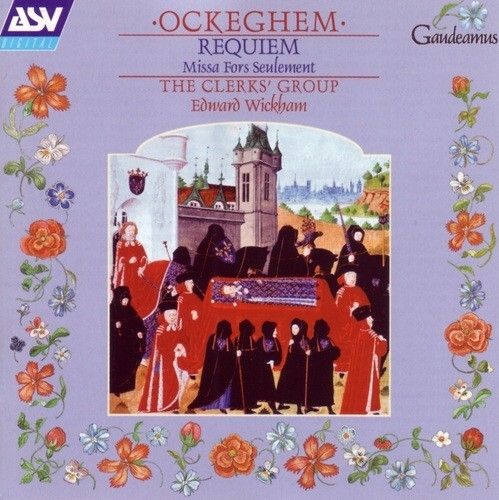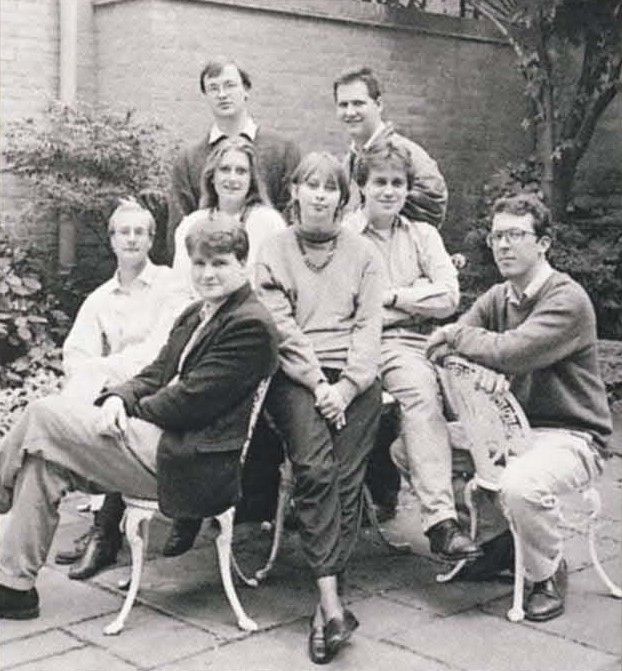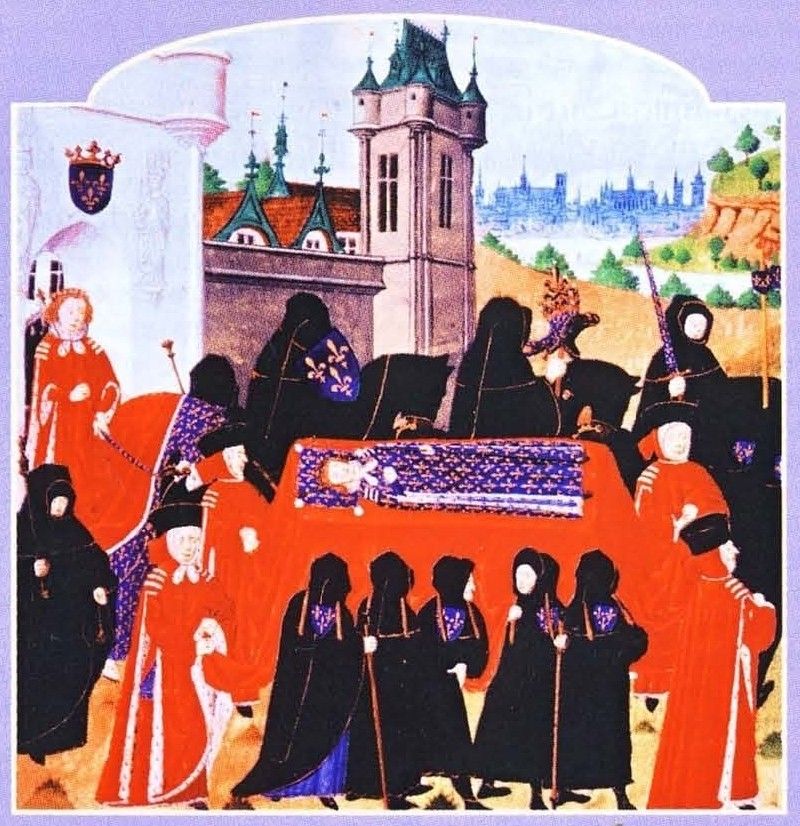Johannes OCKEGHEM. Missa Fors seleument · Requiem / The Clerks' Group
Johannes OCKEGHEM · Pierre de LA RUE · Antoine BRUMEL: Fors seulement

medieval.org
AS&V "Gaudeamus" CD GAU 168
1997
Johannes OCKEGHEM
(c.1410-1497)
Missa Fors seulement
1. Kyrie [3:24]
2. Gloria [5:45]
3. Credo [7:47]
4. Fors seulement
l'attente [8:13]
Pierre de la RUE
(c.1460-1518)
5. Fors seulement
[3:37]
Antoine BRUMEL
(c.1460-1515)
6. Du tout plongiet
~ Fors seulement [12:29]
Johannes OCKEGHEM
Requiem
7. Introitus [4:32]
8. Kyrie [4:29]
9. Graduale [4:52]
10. Tractus [7:44]
11. Offertorium [8:21]
THE CLERKS' GROUP
Edward Wickham
sopranos: Carys Lane, Rebecca Outram
altos: Robin Blaze, William Missin
tenors: Stephen Harrold, Matthew Vine
basses: Edward Wickham, Jonathan Arnold, Robert Macdonald
Produced by Jonathan Freeman-Attwood
Engineered by Paul Proudman and ProudSounds
Recorded at St. Andrew's Church, West Wratting, 5-6 May 1996

In the last two decades of his life, an image emerged of Johannes
Ockeghem as the “elder statesman” of musicians, as a
benign, saintly father-figure, handsome and imposing in physical
appearance, mild-mannered, generous and charitable in his attitude;
pious, wise and learned in his words. In the twentieth century this
image has become highly influential, largely because it seemed
attractively consonant with some of Ockeghem's sacred music, which is
at times unusually suggestive of spiritual depth, reflective piety, and
inward contemplation. No work, with the possible exception of Intemerata
Dei mater, exemplifies those characteristics more compellingly than
the impressive five-part Missa Fors seulement, a setting
generally believed to date from the final decade of Ockeghem's life.
)
There is in fact a general tendency in the Western high-art musical
tradition to typify composers in archetypal literary images: Ockeghem
the saintly father, Josquin the irascible genius, Beethoven the titanic
hero. (Other composers have been typecast as the perennial child, the
effeminate lyricist, the demonic virtuoso, the cold constructivist, and
so on). In many cases, however, the number of compositions that
actually support such an image turns out to be surprisingly small: the
heroic style of Beethoven, for instance, is exemplified by only a
handful of works. Yet it is due partly to the enduring attraction of
this and similar images that those few works have gained paradigmatic
status, have become defining landmarks in our mental map of Western
music history: the B minor Mass, Eroica, the Unfinished, Missa
Pange Lingua. It is these compositions that tend to be recorded,
analysed and discussed over and over again, and (in Renaissance music)
it is these that scholars will immediately invoke when declaring other
works to be “untypical” of the same composer, or even
“spurious” and “inauthentic”.
From this perspective Missa Fors seulement (here recorded on CD
for the first time) seems destined to enter our collective
consciousness as the very quintessence of Ockeghem. The fifteenth
century has left us no other images of the composer that allow us to
accept as equally quintessential such works as the early three-part Sine
nomine Mass (a setting of exquisite sonorities in high vocal
range), or the exuberant five-part motet Gaude Maria virgo (ASV
CD GAU 153) — and scholars have been revealingly zealous to
remove or keep these from Ockeghem's work list, preserving an image as
tidy and one-dimensional as one would expect from a commedia
dell'arte character. Missa Fors seulement neatly fits into
that image. It is without question a masterpiece, arguably one of the
greatest compositions that the fifteenth century has left us. Above
all, however, the Mass has what it takes to attain canonic status.
It was commented above that the later image of Ockeghem was literary,
and it may indeed be no coincidence that all evidence supporting it
comes from circles of literati: men of letters, humanists,
poets and rhetoricians, whose panegyrics of the composer are typically
flowery, hyperbolic, and riddled with poetic clichés. One
example is the well-known eyewitness description by the Italian
humanist Francesco Florio, who visited Tours in the late 1470s:
At the entry of the citadel [of Tours] is the royal chapel, where the
singers of the king sing Mass and Vespers every day. All the musicians,
chosen from throughout the kingdom, are considered excellent, but it is
Johannes Ockeghem, the treasurer of the church of St Martin and master
of the royal chapel, who excels by virtue of his voice and art, in the
same way that Calliope, supported by the favour of Apollo, shines and
easily surpasses the Muses. I am convinced you cannot but love this
man, so much does he distinguish himself by his handsome stature, so
much does he shine by the wisdom of his manner and his words, and also
by his gracefulness. He alone of the singers is free from all vice and
filled with all virtues, and he alone, like the Phoenix of Arabia, must
rightly be honoured and revered.
In several details this description matches the four laments written
after Ockeghem's death, in February 1497. The poet Guillaume Cretin, in
his notoriously hyperbolic and sentimental Déploration,
finds himself transported to the underworld in a dream, and there
witnesses heartrending scenes of sadness and grief. Mythical and
Biblical musicians like Tubal, King David and Orpheus take turns to
lament Ockeghem's death. Then a choir of recently deceased composers
honours him by singing — significantly — four of his
Masses, including the Requiem featured on this disc. Cretin suddenly
wakes up, feeling desperately unable to describe Ockeghem's virtues, at
least without the rhetorical skills of ancient writers, or the help of
contemporary poets like Chastellain, Molinet, Greban and others. In the
end words do not fail him to praise Ockeghem, and he sketches a
portrait characterised by piety, humility, charity, learning and (not
least) old age. Much of Cretin's imagery returns, almost as if by tacit
agreement, in the shorter laments by Molinet (one of which inspired the
setting by Josquin) and Erasmus (later set to music by Lupus). Indeed,
the portrayal of Ockeghem as the grand old man of music, the “bon
père” of composers, the “cantorum pater
almus”, is so strikingly consistent that one cannot blame modern
scholars for viewing him in these very terms.
Equally consistent with this image, as well as the image that arises
from Missa Fors seulement, is the well-known illumination from
a 1530s poetry manuscript: it shows a group of nine singers in front of
a lectern, of whom one is by far the oldest, and portrayed with the
greatest attention to detail: dark and thick-rimmed glasses, a pained
expression, jutting chin, wrinkled forehead, and generous curls of grey
hair. Everything fits together: the unquestionable quality and
profundity of some of his sacred compositions, the saint-like virtues
extolled in the poetic tradition, the venerable old man in the
illumination — perhaps even the senior musical and ecclesiastical
positions we know he held. Yet what sustains the image is ultimately a
literary taste, a taste for archetypal images and narratives, which may
enhance our appreciation of a select group of works (like the stories
surrounding Eroica or the Unfinished), but has little to do
with the artistic merits of those works as compared to others.
Missa Fors seulement is based on Ockeghem's famous rondeau
(presented on this disc with two arrangements by Pierre de la Rue and
Antoine Brumel), material of which is being quoted irregularly and with
great freedom. Stylistically its nearest parallel is the motet Intemerata
Dei mater: both works explore low ranges, and in both the typically
unrelenting “wall of sound” that characterised the 1450s
and 1460s Masses (Caput, De plus en plus, Ecce ancilla Domini)
has given way to a style defined by textural fluidity and diversity.
All these features would suggest a late date, probably not before the
1480s.
The Requiem Mass is one of the great riddles in Ockeghem's oeuvre. Its
various movements are so dissimilar in style, notation and scoring that
one is almost tempted to suggest that the Mass is an ad hoc compilation
of fragments from different requiems. The opening Introitus is kept in
a simple style such as was still very common in the late 1440s, and
contains some curious unorthodoxies of part-writing (note especially
the unblushed parallel fifths on “dona”, right at the
beginning). The same is true of the subsequent Kyrie, but thereafter we
seem to be drawn into a different musical world. The final Offertory, Domine
Jesu Christe, is stylistically and notationally as far removed from
the initial Introitus as it could possibly be, and is characterised by
a compositional sophistication and melodic intricacy unmatched
elsewhere in Ockeghem's sacred oeuvre. Like the preceding Tractus Sicut
cervus, moreover, it exhibits an expressive intensity and textural
variety that recalls late works such as Missa Fors seulement
and Intemerata Dei mater. In all, it is hard to think of the
Requiem as the result of a single creative act — nor is there
necessarily any reason why we should assume that it was.
Is there any historical truth to the late Ockeghem image, or was it
merely a literary cliché that a select group of humanists and
poets projected upon him, much like the “genius” stereotype
later projected upon Josquin? Sadly, there is no way of telling, since
hardly anything is known about the composer personally except as
illuminated by the warm glow of contemporary poetic veneration. Other
than that, all we possess is a mere skeleton of documentary references:
a payee at the royal court, a cleric involved in litigation, a vendor
and buyer of property — administrative entities about whom
nothing is individual but the name, “maistre Jehan
Ockeghem”. Our historical engagement with him is destined to
remain like the dream in Cretin's Déploration, and in so
many other Medieval narratives: an imaginary journey into a distant
realm where image, truth and illusion are all experienced as real, and
from which we return never knowing which is which.
© Rob C. Wegman 1997



